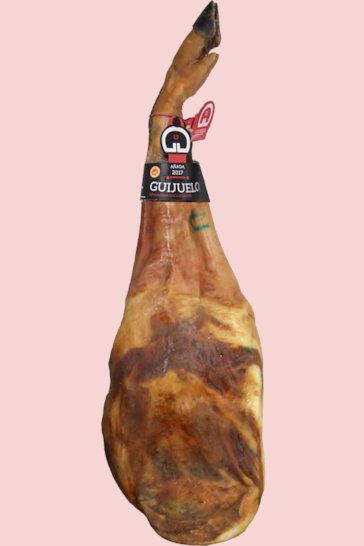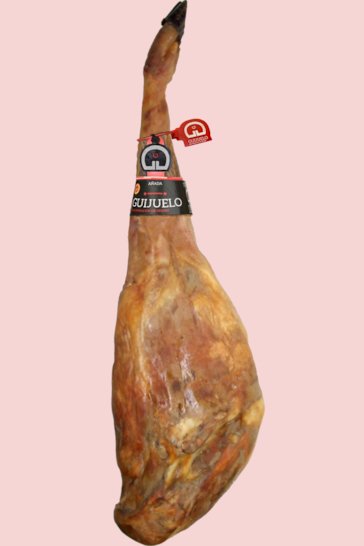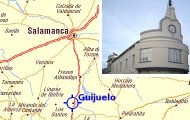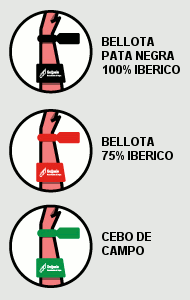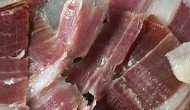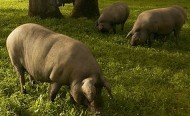Guijuelo is a town with a population around 10,000 in the southeast of Salamanca (Spain). It is the location of the central offices of the Regulatory Board for the Guijuelo Designation of Origin, created over 30 years ago and a pioneer in the jamon sector.
Iberian pigs come from various parts of Spain: Salamanca, Extremadura, Cordova, Huelva, Seville and Castile La Mancha, but the jamones are cured and aged only in the Guijuelo area. Its microclimate is essential for the curing process, which takes place in over 200 plants in towns such as Guijuelo, Ledrada, Sotoserrano, Miranda del Castañar, Béjar, Candelario, Frades de la Sierra, and Tamames.
Bone-in, Boneless & Sliced
Bone-in, Boneless & Sliced
Guijuelo is situated on the Iberian plain over one thousand metres above sea level. It is bordered on the east by the Tormes River, on the west by Mt. Tonda and on the south by two mountain ranges: Sierra de Béjar and Sierra de Gredos. The microclimate is characterised by cold, dry winters and short, mild summers, ideal for perfect drying and excellent ageing of jamones.
Iberian jamones have been produced here since the Middle Ages, alongside other industries like leather tanning, footwear and soap. But in the past 100 years the sausage and jamon industry has grown dramatically, thanks in part to the efforts made by the producers' associations and other local organisations to expand trade and information.
International fame dates from long ago. In 1892 a journalist named Wanderer published an article entitled "Candelario in the land of jamones and sausages", analysing the jamon and sausage industry in this town.
Only purebred Iberian pigs or a cross of 75% Iberian and 25% Duroc-Jersey can be used for jamones and paletas (shoulder hams) under this PDO.
There are two grades of jamones based on the pigs' diet before slaughter:
The Regulatory Board monitors the entire production process, from the farms (breed, breeding, rearing, fattening or free-range fattening) until curing. After the animals have been butchered in a slaughterhouse registered with the Regulatory Board, the cuts are marked with an indelible stamp consisting of two letters identifying the batch.
Genuine acorn-fed Iberian pigs are butchered after a period of unperturbed rooting on the open range, and the jamones undergo complete chromatographic testing. The result of this analysis is a provisional grade: a numbered red seal for bellota-grade Iberian jamones and paletas (shoulder hams) and green for Iberian grade.
The jamon or paleta then begins a lengthy process lasting two and a half or three years under the watchful eye of master jamon processors. The first stage is curing, which lasts six months and is required for proper preservation. Then comes ageing, when the jamones and paletas undergo changes in taste and aroma resulting from a biochemical process that, together with the attributes of the raw material, gives them their traditional quality, especially their characteristic flavour and aroma.
Guijuelo jamon stands out from the others on account of its sweet and delicate flavour. It is the coldest of all the regions where Iberian jamon is cured, allowing less salt to be used and the jamones to be cured for a longer period. This results in a less potent flavour, and one that does not leave an aftertaste on the palate or in the throat as, for example, a Jabugo jamon may do, but it does offer an extremely interesting aromatic complexity.
The characteristics of Guijuello DO jamones and paletas are:
The deep red colour that appears on cutting is typical of free-range animals of advanced age (18 months). The marbling fat causes the glossy white streaks that characterise Iberian pork products and makes them juicy and tender. The intense, persistent aroma and flavour come from long ageing. Guijuelo jamon is also known for its low salt content, resulting from optimum climate conditions that make the salting period shorter than in other parts of Spain.
| Cut weight of the piece at the slaughterhouse | Minimum ageing time in the cellar | Expected weight after cellar ageing | |
|---|---|---|---|
| Jamones | from 7 to 8 kg | 9 months | from 4.5 to 5 kg |
| from 8 to 11 kg | from 9 to 12 months | from 5 to 7.5 kg | |
| more than 11 kg | 16 months | more than 8 kg | |
| Paletas | 5 kg | 5 months | from 3.5 to 4 kg |
| more than 5 kg | 6 months | more than 4 kg |
| Moisture | 30% |
|---|---|
| Proteins | 30% |
| Fat | 30%, of which 70% are unsaturated fatty acids that do not produce cholesterol and are essential in the human diet |
| Calories | 170 (per 100 g) |
A total of 605,752 seals were issued in 2004 and 256,081 bellota cuts with bands went onto the market. In 2005 the figure for seals was 863,409, and 342,808 bellota jamones and paletas protected by bands went onto the market, the highest percentage in the history of the PDO. In 2012, 868,875 jamones and paletas went onto the market (264.650 bellota-grade and 604.225 cebo-grade).
